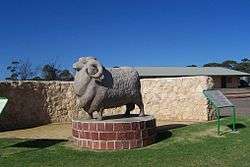Karoonda, South Australia
| Karoonda South Australia | |||||||||||||
|---|---|---|---|---|---|---|---|---|---|---|---|---|---|
 Main Street of Karoonda | |||||||||||||
 Karoonda | |||||||||||||
| Coordinates | 35°5′S 139°53′E / 35.083°S 139.883°ECoordinates: 35°5′S 139°53′E / 35.083°S 139.883°E | ||||||||||||
| Population | 514 (2006 census)[1] (2006) | ||||||||||||
| Postcode(s) | 5307 | ||||||||||||
| LGA(s) | District Council of Karoonda East Murray | ||||||||||||
| State electorate(s) | Hammond | ||||||||||||
| Federal Division(s) | Barker | ||||||||||||
| |||||||||||||

Karoonda is in the middle of the Murray Mallee region of South Australia at geographic coordinates 35°05′S 139°53′E / 35.083°S 139.883°E (60 km northeast of Murray Bridge). Karoonda takes its name from the Aboriginal word for "winter camp". The current boundaries include the former town of Lowaldie, which was the next stop on the railway line away from Adelaide.
Karoonda was founded on wheat growing early in the 20th century (proclaimed on 11 December 1913), but the cleared land is also suitable for raising merino sheep. The Karoonda Development Group instigated and built a larger-than-life sculpture of a Merino ram in the park in the main street to emphasise this. There are even seats with rams heads dotted around the town. A number of other agricultural and horticultural industries are now also represented in the district. Each year the Karoonda Farm Fair is held, a two-day event attracting over 10,000 visitors to the town.
Karoonda briefly shot to international fame in 1930 when a meteorite fell to earth just to the east of the town on the night of 25 November.
Karoonda Area School was the first area school in South Australia.
Karoonda is in the District Council of Karoonda East Murray, the state electorate of Chaffey and the federal Division of Barker.
Pioneer Park on East Terrace is being developed as a Malleelands Pioneer Railways and farm museum, with displays of harvest machinery, plows, railway rolling stock and facilities already in place. The Nature Trail & Bush Walk is adjacent.
Railways
Railways were built in 1911-1914 to open up the mallee. Karoonda was on the Brown's Well railway line (extended to Barmera in 1928) and became a junction with the Waikerie railway line to the north and the Peebinga railway line to the east (south of the main line).[2] Both branches were closed in 1990, but the main line through Karoonda remains open as the Loxton railway line and was converted from broad gauge to standard gauge.
Lowaldie
The Lowaldie railway station was 6.25 miles (10.06 km) east of Karoonda and also had a small town surveyed, with a school and post office operating for some time. These have all closed, and the former institute building is used as a private residence. The station was originally named Lowalde in 1913, but when the town was proclaimed in 1914, the spelling used was Lowaldie. The name is derived from a Ngarrindjeri word meaning summer.[3]
Photo gallery
| Wikimedia Commons has media related to Karoonda, South Australia. |
 Post Office
Post Office General Store
General Store ABB Silos
ABB Silos Old Railway Station
Old Railway Station Police Memorial, Railway Tce
Police Memorial, Railway Tce Lions Pioneer Park
Lions Pioneer Park Painting at Parking Bay
Painting at Parking Bay Memorial Gates at the Oval
Memorial Gates at the Oval Obelisk
Obelisk Obelisk
Obelisk Area School
Area School Area School
Area School Oval
Oval Institute
Institute Hospital
Hospital Karoonda Pub
Karoonda Pub "All Hallows" Anglican Church
"All Hallows" Anglican Church St Finian's Catholic Church
St Finian's Catholic Church St Johns Lutheran Church
St Johns Lutheran Church Uniting Church
Uniting Church Op-Shop
Op-Shop Ambulance Station
Ambulance Station CFS Station
CFS Station Police Station
Police Station
References
- ↑ Australian Bureau of Statistics (25 October 2007). "Karoonda (State Suburb)". 2006 Census QuickStats. Retrieved 2008-02-28.
- ↑ Rail Line to Nowhere Southwell, J.G. Australian Railway Historical Society Bulletin, July, 1971 pp146-151
- ↑ "Placename Details: Lowaldie". Property Location Browser. Government of South Australia. 12 May 2011. Retrieved 12 February 2016.
Narinyeri word meaning summer. Town surveyed in November 1913. Name altered when the town was proclaimed - no indication is given on the glossary card as to the name originally proposed but old cards show Lowalde. Town diminished in February 1938. Now incorporated into the bounded locality of Karoonda.